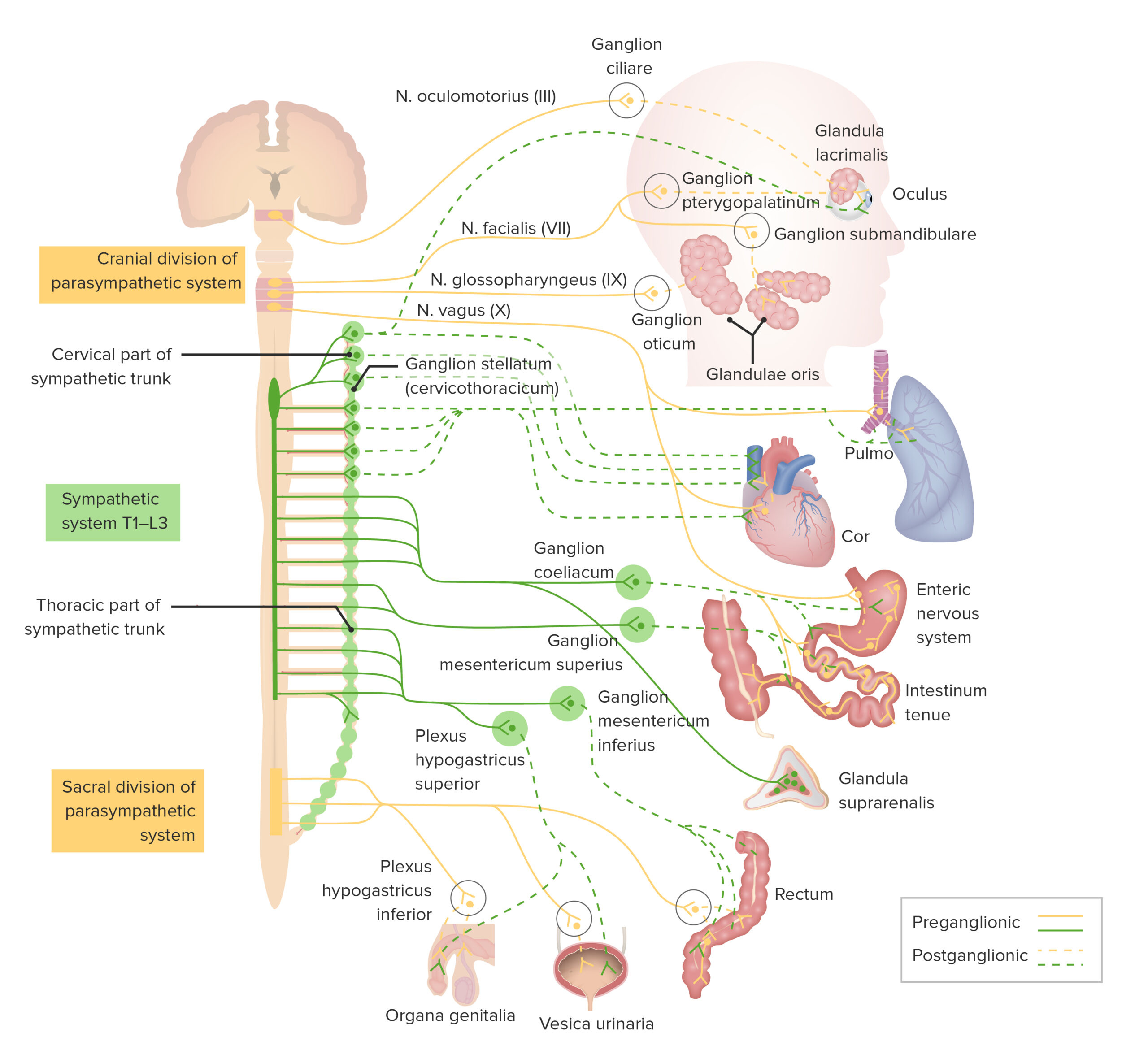Playlist
Show Playlist
Hide Playlist
Autonomic Nervous System: Skin Appendages and Other Tissues
-
Slides 07 AutonomicEffectors NervousSystem.pdf
-
Download Lecture Overview
00:01 Now, let’s address some of the skin specific components. 00:06 We already talked about blood vessels in the previous one, but now we’re gonna go through and talk about the skin appendages. 00:13 And you might ask, appendages? I don’t have anything growing off my skin -- maybe you do -- Sweat glands are called skin appendages because they are part of the glandular structure but they will end up being a structure of their own. 00:32 They are mediated by the sympathetic nervous system and muscarinic receptors. 00:38 Wait, I said muscarinic receptors, did you mean it? Yes, I did. 00:45 This is a rare time when the sympathetic nervous system is using a muscarinic receptor. 00:52 Typically, these are for the parasympathetic nervous system, right? Correct, but in this case this is an exception to the rule where you use acetylcholine as the primary neurotransmitter and bind to muscarinic receptors and it’s still under sympathetic control. 01:09 The other type of skin appendage is hair and so hair is sticking off the skin. 01:19 You can modulate the hair though by contracting piliary muscles. 01:25 These pilomotor muscles allow for hair to stand up and this would be in a time when you’re very cold or if you’re nervous and your hair starts standing up and this also can make little kind of piliary bumps or what we like to call goosebumps. 01:44 These are mediated by alpha adrenergic receptors and this is contraction of that smooth muscle. 01:51 You notice that the parasympathetic nervous system here doesn’t activate skin appendages. 01:57 Let’s now move on to tear glands. 02:03 So lacrimal glands are innervated by the parasympathetic nervous system and the muscarinic receptors increase their secretions. 02:13 The liver is important in being able to do a lot of different functions for the body. 02:19 In this case, it is gonna be innervated by the sympathetic nervous system. 02:24 It is going to be involved in gluconeogenesis which is the production of new glucose. 02:30 It is also involved in glycogenolysis and that is the breakdown of glycogen. 02:37 Both of these two things will do increasing blood glucose; either gluconeogenesis making new glucose or breaking down glycogen into glucose, the liver then can release it so then the rest of the body can utilize it. 02:52 Adipose tissue is innervated by the autonomic nervous system. 02:56 You wouldn’t necessarily think of this, would you? Why would fat be innervated by the autonomic nervous system? But there are a couple of times from sympathetic events that it makes it important. 03:08 Let’s go through those. 03:10 Adipose tissue has beta3-adrenergic receptors. 03:13 These receptors if engaged by epinephrine or norepinephrine, cause lipolysis. 03:20 Lipolysis is the breakdown of fat, then what you would do is the adipose tissues will release free fatty acids into the blood. 03:28 Another tissue that’s also adipose tissue is called the brown adipose tissue. 03:34 Brown adipose tissue especially in the infant is important for thermoregulation. 03:40 They utilize the same beta3-adrenergic receptors and end up causing heat production. 03:46 So both white fat and brown fat are innervated by the sympathetic nervous system. 03:52 The kidney is innervated by the sympathetic nervous system and it does this to help regulate things like the blood flow and glomerular filtration rate. 04:01 The other thing that it does is stimulate the release of rennin. 04:06 And remember, renin was such an important molecule in starting the renin-angiotensin-aldosterone system. 04:13 The RAAs system allows you to reabsorb sodium and water and this is an important process that is mediated by beta1-adrenergic receptors.
About the Lecture
The lecture Autonomic Nervous System: Skin Appendages and Other Tissues by Thad Wilson, PhD is from the course Neurophysiology.
Included Quiz Questions
Which of the following statements is correct regarding the autonomic nervous system?
- Both sympathetic and parasympathetic nerves control salivary gland production.
- Parasympathetic stimulation decreases sweat production.
- Inhibition of muscarinic receptors in the skin increases sweat production.
- Pilomotor response is modulated by parasympathetic activation.
- Tear production is deceased with activation of the parasympathetic system.
Which of the following statements regarding autonomic regulation is INCORRECT?
- Sympathetic stimulation causes decreased gluconeogenesis.
- Parasympathetic activation does not impact liver metabolism.
- Sympathetic stimulation increases gluconeogenesis.
- Sympathetic stimulation of the kidneys will cause the release of renin.
- Parasympathetic nerves do not modulate renal function.
Customer reviews
5,0 of 5 stars
| 5 Stars |
|
1 |
| 4 Stars |
|
0 |
| 3 Stars |
|
0 |
| 2 Stars |
|
0 |
| 1 Star |
|
0 |
Thank you Doctor Wilson for your simple and understandable lecture.




